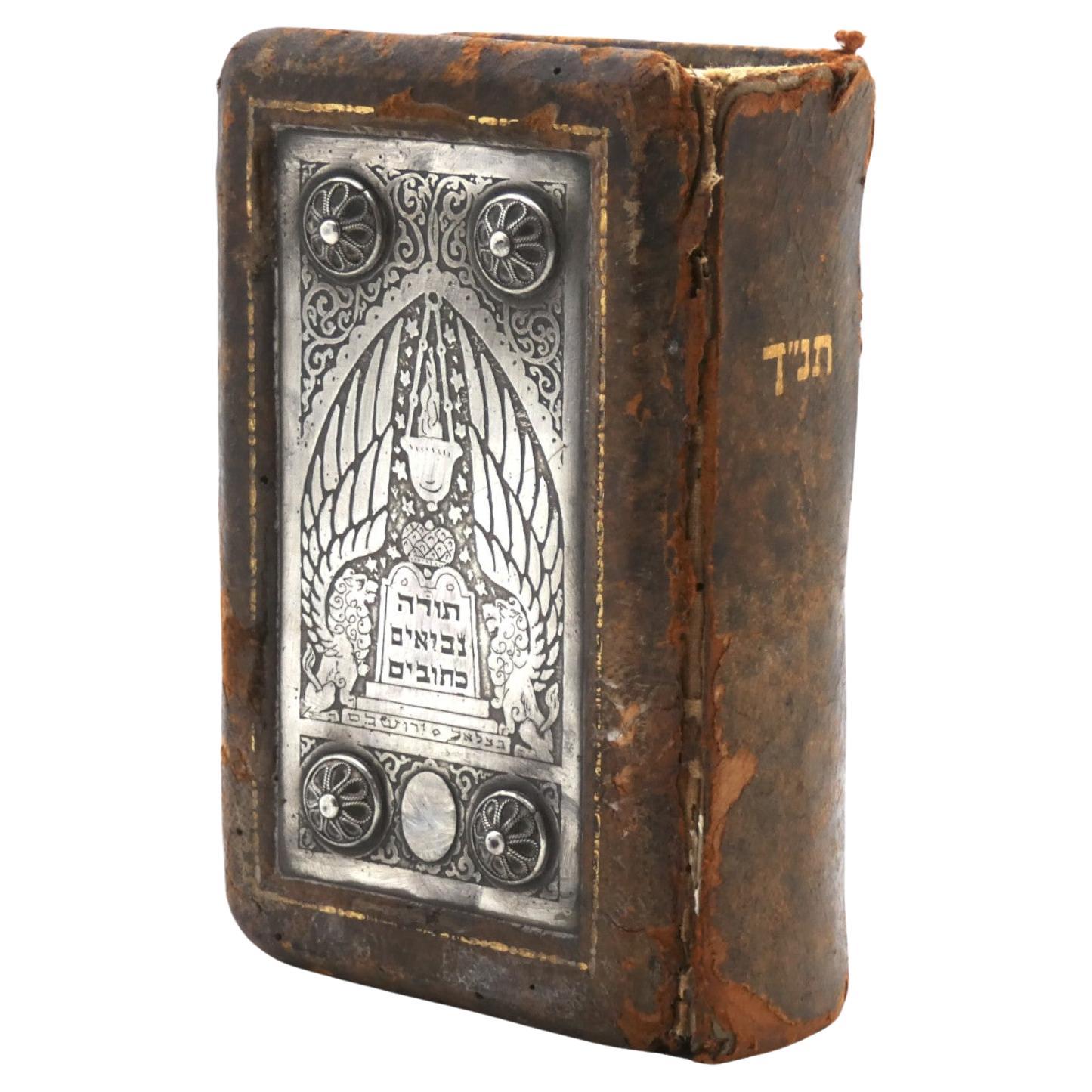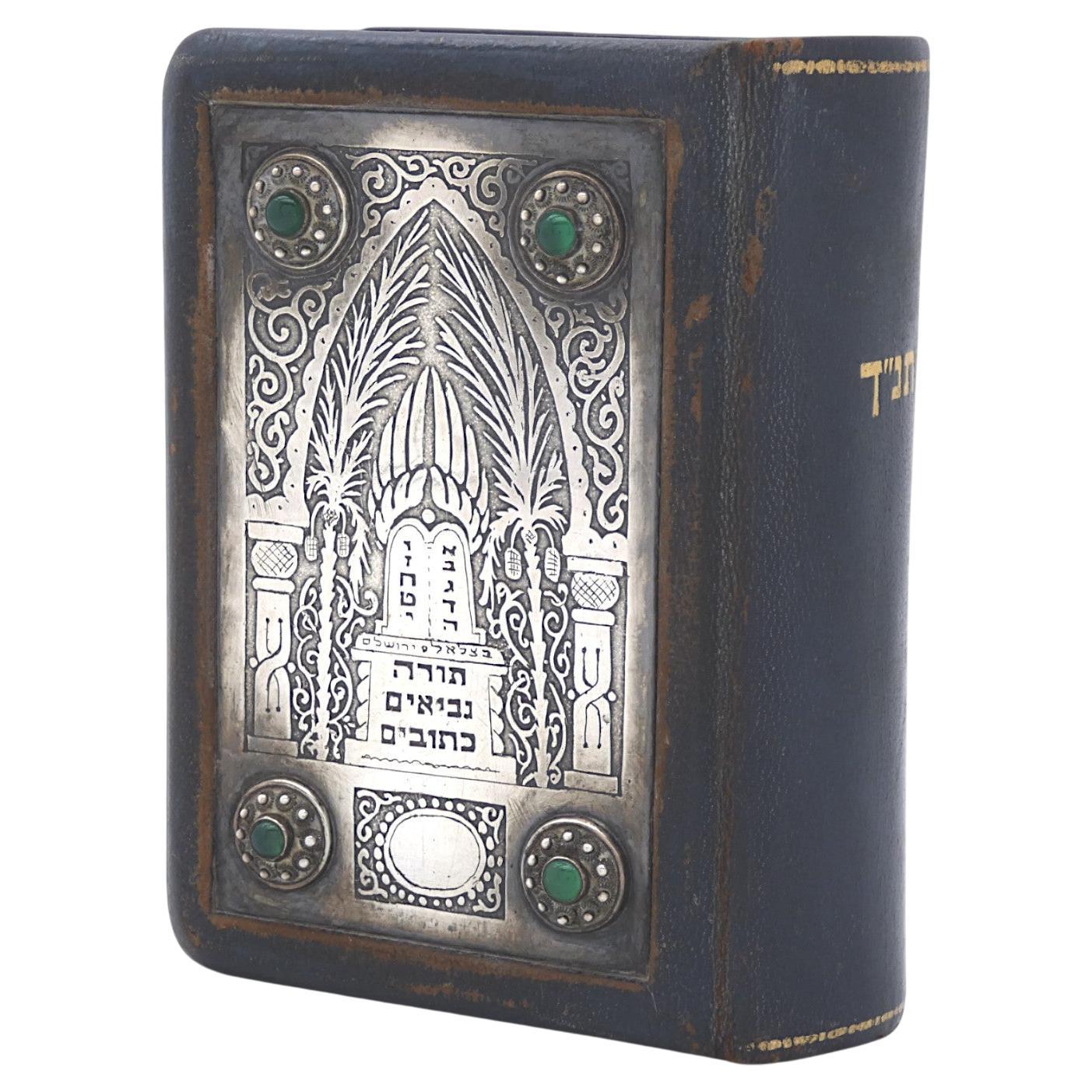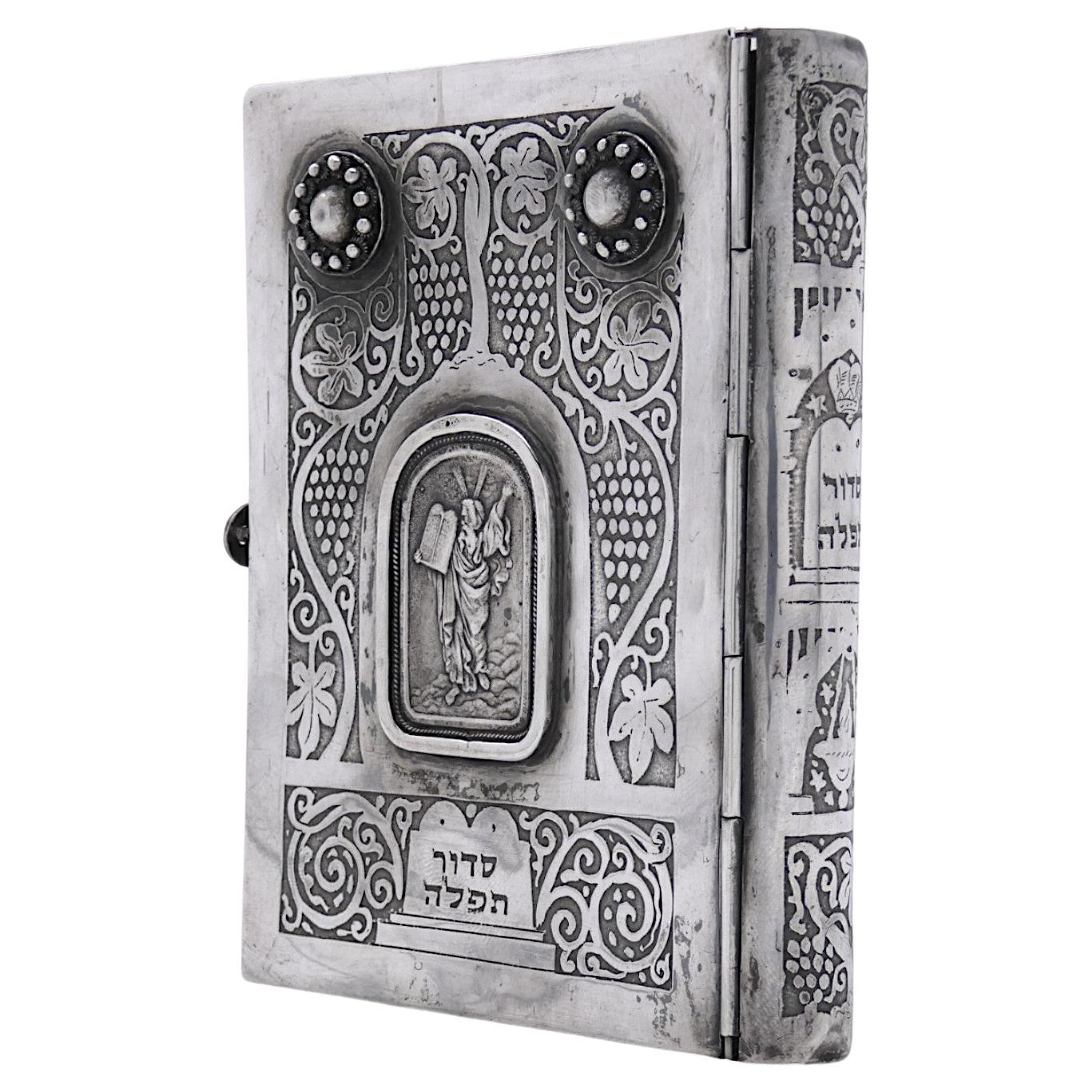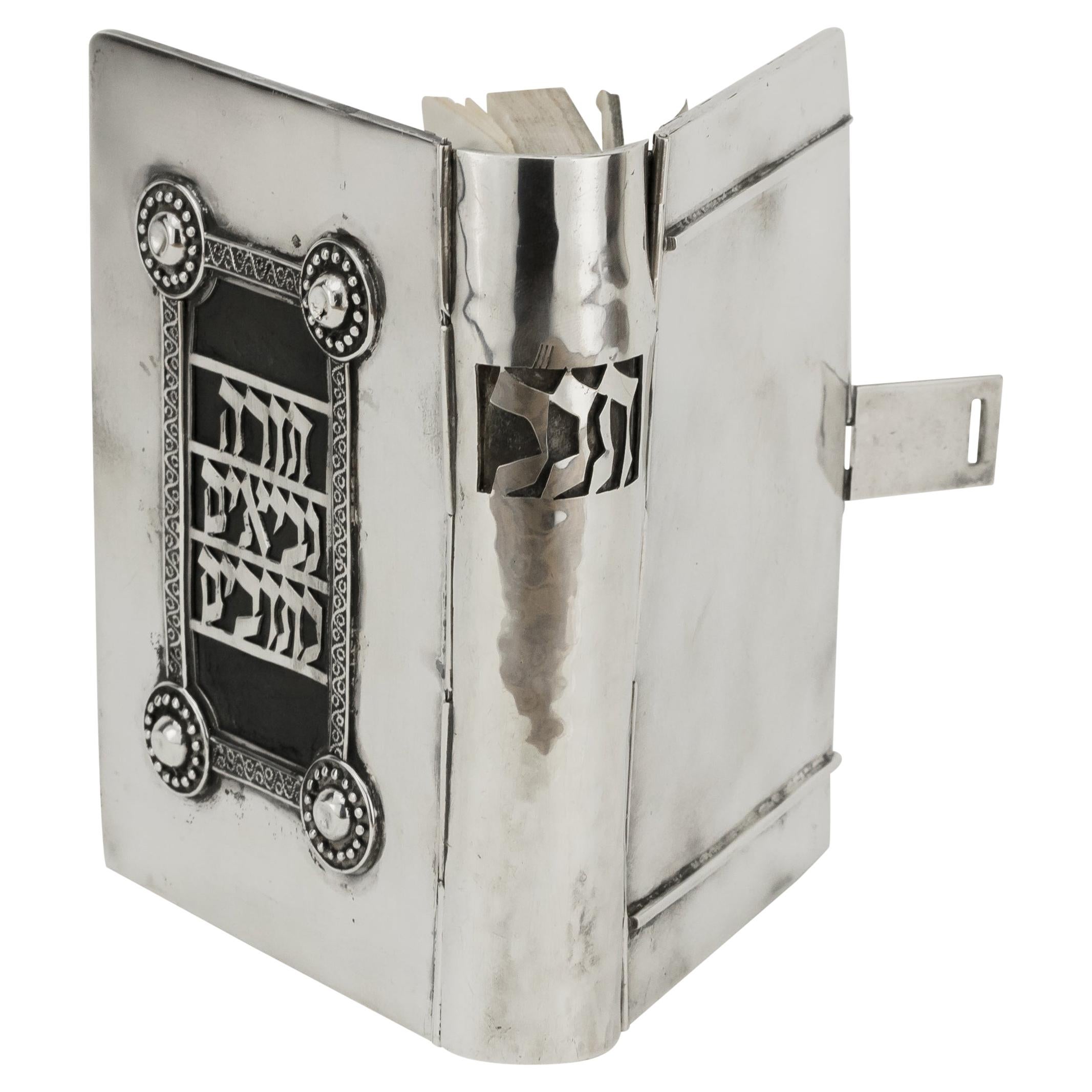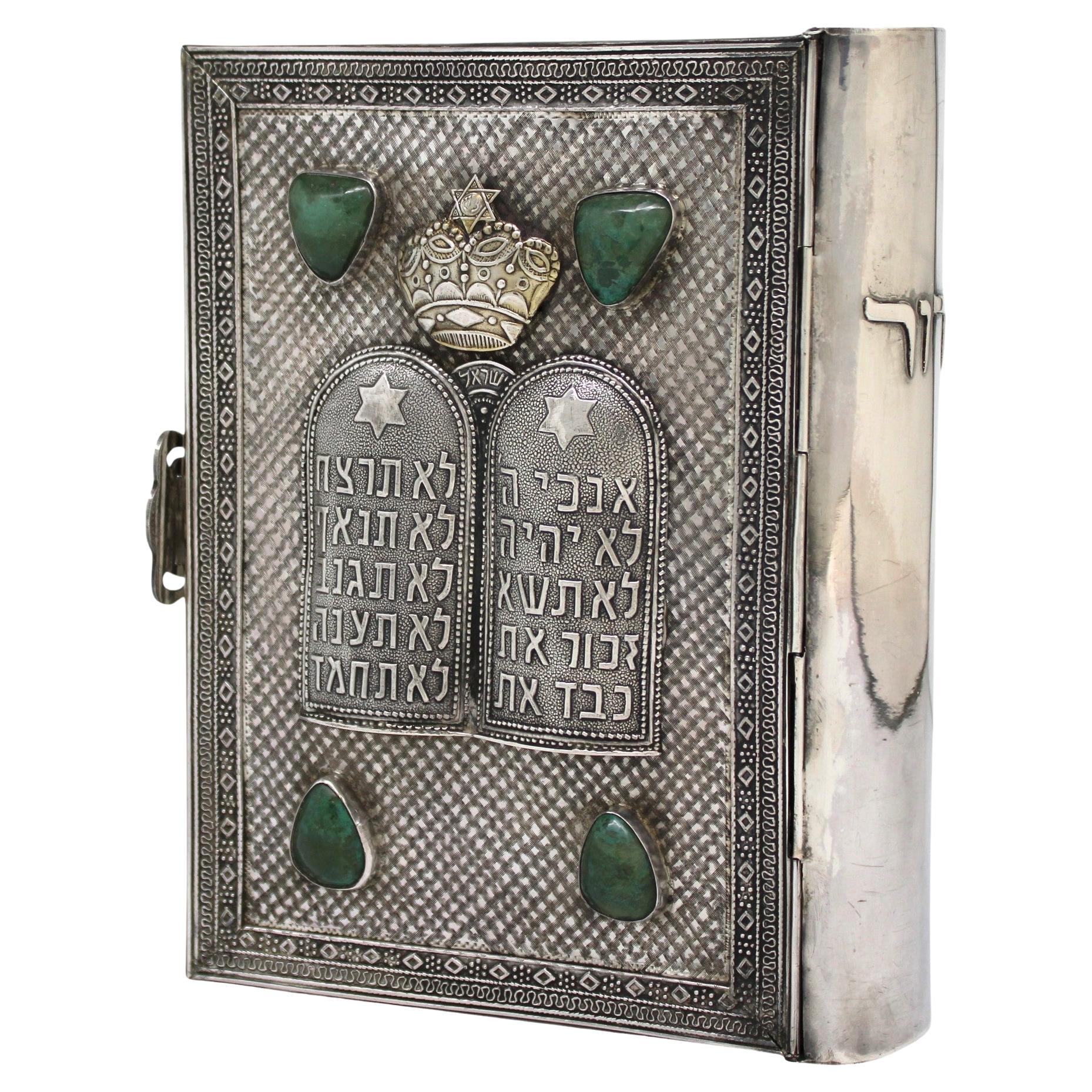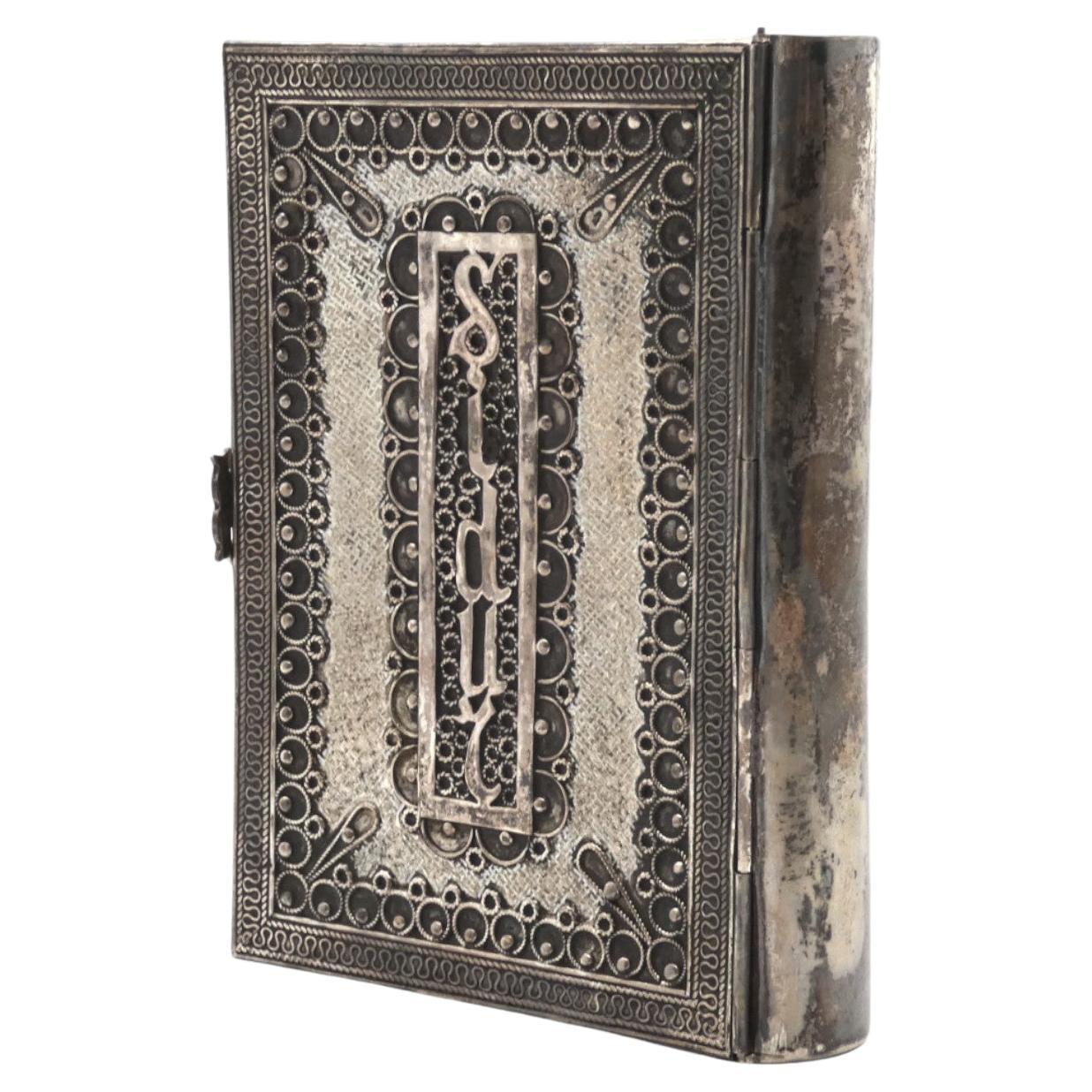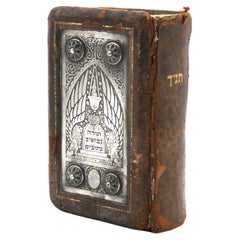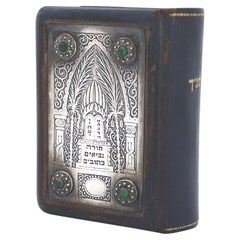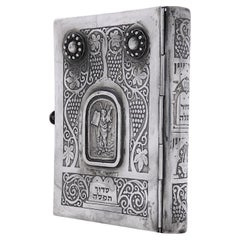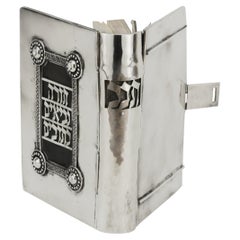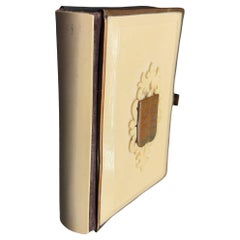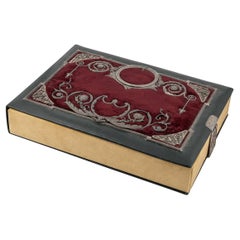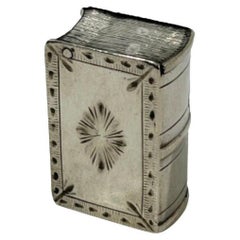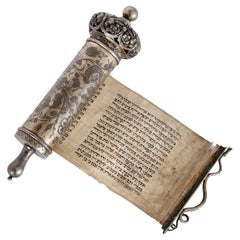Items Similar to A Silver and Leather Bezalel Book Binding, Israel Circa 1940
Want more images or videos?
Request additional images or videos from the seller
1 of 8
A Silver and Leather Bezalel Book Binding, Israel Circa 1940
$2,000
$2,50020% Off
£1,519.16
£1,898.9520% Off
€1,750.59
€2,188.2420% Off
CA$2,816.50
CA$3,520.6220% Off
A$3,122.50
A$3,903.1320% Off
CHF 1,641
CHF 2,051.2520% Off
MX$38,214.30
MX$47,767.8720% Off
NOK 20,494.38
NOK 25,617.9720% Off
SEK 19,236.02
SEK 24,045.0320% Off
DKK 13,067.08
DKK 16,333.8520% Off
About the Item
A Silver and Leather Bezalel Book Binding from Israel circa 1940 is a prominent piece of Judaica. Bezalel, the name associated with the Bezalel School of Arts and Crafts in Jerusalem, is known for its significant contributions to Jewish art and craftsmanship in the early 20th century.
The Bezalel School was founded in 1906 by Boris Schatz in Jerusalem. It aimed to blend European artistic traditions with Middle Eastern and Jewish themes. By the 1940s, the Bezalel School had established a reputation for high-quality, handcrafted Judaica that incorporated traditional Jewish motifs and modern design elements.
A picturesque bible printed by Sinai Publishing in Tel Aviv is bound within the sumptuous brown leather binding. An acid-etched silver cartouche with vine and grape cluster motifs is applied on the cover. Four roundels with floral filigree scrolling are embellished at the corners with an intricate Tree of Life designed with fine filigree and a Decalogue at the center. Surrounding the center design are the words "This is the Tree of Life, for All Who Clutch Onto It" prominently written in Hebrew, and the words "Tanach" and "Bezalel Jerusalem" below.
The craftsmanship and materials used indicate that the book was likely a prized possession, used for significant religious observances or special occasions.
Judaica items from the Bezalel School are highly valued for their artistic merit and historical context.
The blend of traditional Jewish themes with the innovative designs of the Bezalel School makes these pieces particularly significant.
Marked at the lower end of the silver cartouche at the front.
- Dimensions:Height: 4.93 in (12.5 cm)Width: 3.67 in (9.3 cm)Depth: 1.86 in (4.7 cm)
- Materials and Techniques:
- Place of Origin:
- Period:
- Date of Manufacture:1940s
- Condition:Wear consistent with age and use. Minor fading. Leather binding is a bit rubbed at the top of the spine.
- Seller Location:New York, NY
- Reference Number:1stDibs: LU5281240243682
About the Seller
5.0
Recognized Seller
These prestigious sellers are industry leaders and represent the highest echelon for item quality and design.
Established in 2006
1stDibs seller since 2020
134 sales on 1stDibs
Typical response time: 8 hours
- ShippingRetrieving quote...Shipping from: Pomona, NY
- Return Policy
Authenticity Guarantee
In the unlikely event there’s an issue with an item’s authenticity, contact us within 1 year for a full refund. DetailsMoney-Back Guarantee
If your item is not as described, is damaged in transit, or does not arrive, contact us within 7 days for a full refund. Details24-Hour Cancellation
You have a 24-hour grace period in which to reconsider your purchase, with no questions asked.Vetted Professional Sellers
Our world-class sellers must adhere to strict standards for service and quality, maintaining the integrity of our listings.Price-Match Guarantee
If you find that a seller listed the same item for a lower price elsewhere, we’ll match it.Trusted Global Delivery
Our best-in-class carrier network provides specialized shipping options worldwide, including custom delivery.More From This Seller
View AllA Silver and Leather Bezalel Book Binding, Jerusalem Circa 1930
Located in New York, NY
A Silver and Leather Bezalel Book Binding from Israel circa 1940 is an important piece of Judaica. Bezalel, the name associated with the Bezalel School of Arts and Crafts in Jerusalem, is known for its significant contributions to Jewish art and craftsmanship in the early 20th century.
The Bezalel School was founded in 1906 by Boris Schatz in Jerusalem. It aimed to blend European artistic traditions with Middle Eastern and Jewish themes. By the 1930s, the Bezalel School had established a reputation for high-quality, handcrafted Judaica that incorporated traditional Jewish motifs and modern design elements.
A Bible printed by a publishing company in London, Great Britain in 1932 is bound within an original brown leather binding. Vine, grape cluster motifs, two winged lions flanking a crowned Decalogue, and a flaming Ner...
Category
Vintage 1930s Israeli Sterling Silver
Materials
Silver
$2,000 Sale Price
20% Off
A Leather and Silver Bookbinding by Bezalel , Jerusalem Circa 1913
Located in New York, NY
A Rare Leather and Silver Bookbinding by Bezalel made for a Bible, in Jerusalem Israel Circa 1913.
Besides the unique craftmanship that went into making this attractive leather bind...
Category
Vintage 1910s Israeli Sterling Silver
Materials
Silver
$3,600 Sale Price
20% Off
A Silver Bezalel Bookbinding, Israel mid-20th Century
Located in New York, NY
A Distinguished Silver Bezalel Bookbinding made in Israel in the mid-20th Century.
The silver Bezalel book binding is a classic example of the handiwork that was made in the mid-20...
Category
Mid-20th Century Israeli Sterling Silver
Materials
Silver
$2,400 Sale Price
46% Off
Mid-20th Century Israeli Silver Book Binding by Yaakov Ettlinger
Located in New York, NY
Tanach (Five Books Of Moses) with silver binding, handmade with dedication handwritten and signed by the President of Israel, Shimon Peres.
With the fiv...
Category
Vintage 1950s Israeli Mid-Century Modern Religious Items
Materials
Silver
$5,060 Sale Price
46% Off
A Sterling Silver Siddur Binding Israel C. 1950
Located in New York, NY
This exquisite sterling silver Siddur binding is a masterful work of Judaica, crafted with exceptional artistry and devotion. The front cover is adorned with a striking depiction of ...
Category
Mid-20th Century Israeli Sterling Silver
Materials
Sterling Silver
A Silver Prayer Book Binding, Israel 1950's
Located in New York, NY
A Silver Prayer Book Binding from Israel in the 1950s represents a significant piece of Judaica, blending traditional religious devotion with the ar...
Category
Vintage 1950s Israeli Sterling Silver
Materials
Silver
$1,280 Sale Price
20% Off
You May Also Like
Victorian Daily Prayer Book in Hebrew "Tephilath of Israel" w/ Carved Bone Cover
Located in Van Nuys, CA
Antique prayer book in Hebrew ("Tephilath Israel" meaning "Prayer of Israel") published in Vienna in 1894 by Jos. Schlesinger. The book is made with a binding of celluloid over cloth...
Category
Antique 1890s Austrian Late Victorian Books
Materials
Brass
$405 Sale Price
40% Off
Antique 19th Century Russian Solid Silver, Velvet & Leather Book Cover c.1890
Located in Royal Tunbridge Wells, Kent
Antique 19th Century Russian solid silver book cover, featuring velvet and leather. The front is adorned with burgundy velvet and intricate silver de...
Category
Antique 19th Century Russian Other Books
Materials
Silver
19th Century Silver Loderein Box in the Shape of a Book
Located in Delft, NL
A 19th century silver loderein box in the shape of a book
A silver loderein box in the shape of a book with engraving. 19th century.
Under the box ha...
Category
Antique 19th Century Models and Miniatures
Materials
Silver
Large Russian Silver Jewish Megillah Case and Scroll
Located in London, GB
A large Russian silver Jewish Megillah case and scroll
Russian, 19th century
Measures: height 23cm, diameter 7cm
This remarkable piece is a Russian ...
Category
Antique 19th Century Russian Religious Items
Materials
Silver
Antique Embossed Silver Plate & Leather Photo Album in Case C1880
Located in Big Flats, NY
Antique Embossed Silver Plate & Leather Photo Album in Case C1880.
Measures - 13.25"H x 11.5"W x 4.25"D.
An exquisite antique photo album from circa 1880, featuring an embosse...
Category
Antique 19th Century Sheffield and Silverplate
Materials
Silver Plate
$360 Sale Price
20% Off
extremely rare Algerian Judaica silver, jewish Dowry box early 19th century
Located in Tel Aviv - Jaffa, IL
Amazing and scarce JUDAICA object, we have here one of the most touching jewish objects we had for a long time, this small silver dowry box was made in Algeria in the early 19th century, it is all covered with symbols of jewish faith and of couples, the sliding lid has 2 flanking birds with hamsa (protective hand) on each side and a flower vase in the middle.
one side shows two flanking lions with a tree in the middle and the other side shows again two big and two small birds with a flower bowl in the middle, front side has a key hole and next to it there is the Hebrew inscription ס״ט״" which says Siman tov or in English "a good sign" it is taken from the wedding blessing, underneath the lock there is another inscription with the name ״עזיזה בת אברהם בן חמו״ which is the name of the bride, her father and her grandfathers name.
the box is full marked a lot of times with the silversmith mark, every side of the box is marked.
this box was probably ordered by the grooms family to hold the jewelry they are giving to the bride as dowry, this type of objects are rare and there are just a few of them on museum collections.
DOWRY (Heb. נְדֻנְיָה), the property a wife brings to her husband at marriage; the Yiddish equivalent, nadn, is from the same root. The custom of nedunyah became clearly defined and institutionalized only in the talmudic period. In biblical times, mohar (מֹהַר), whereby the groom bought his wife from her father (Gen. 24:53; Ex. 22:15–16; Hos. 3:2), was the accepted practice. It was then customary that the groom give the bride gifts, and that she bring certain property to her husband's home upon marriage: slaves, cattle, real estate, etc. (cf. Gen. 24:59–61; 29; Judg. 1:14ff.; I Kings 9:16). Evidence of the custom of nedunyah is to be found in Tobit (7:14; 8:21) and in the Assuan papyri (Cowley, Aramaic, nos. 15, 18). Gradually, mohar was superseded by the ketubbah custom according to which the husband merely assumed the responsibility of compensation to his wife in case he divorced her: he had to pay her 200 zuzim if she had been a virgin at the time of marriage, and 100 zuzim if a widow or divorcée (see *Ketubbah).
By talmudic times, the institution of nedunyah was prevalent; the father gave a dowry to the bride since the daughter was excluded from paternal inheritance. Fifty zuzim (equivalent to the worth of 180 grams of silver) was the minimum amount a father was obliged to give to his daughter (Ket. 6:5). Parents usually gave much more, according to their social standing. Community funds provided the dowry for an orphan or a very poor girl (ibid.; cf. Sh. Ar., YD 251:8). In case of her father's death, the brothers of a minor girl were obliged to give her the minimum dowry, and the court estimated how much her father would have given her above the minimum dowry. The sum was then taken out of the father's estate and given to the daughter upon majority (Ket. 6:6; 68a–69b). In the absence of such an estimate, each daughter was entitled to receive one-tenth of the value of her father's estate in money, or in valuables (Yad, Ishut, 20:4–7; Sh. Ar., EH 113:4). If the father was unable or unwilling to pay the promised dowry at the betrothal ceremony, the groom could refuse to marry his bride (Ket. 13:5; Ket. 108b–109a). Insistence on exact payment of the promised dowry, however, was frowned upon by later rabbinic authorities (Rema to Sh. Ar., EH 2:1). In certain communities it was customary for the groom's father to make a dowry contribution equal to that of the bride's father (Ket. 102b). The dowry, whether given in real estate, slaves, money, or chattel was recorded in the marriage contract (the ketubbah) and in some instances one-third or one-fifth of the actual value of the dowry was added to the sum mentioned in the ketubbah. Based upon a decree enacted by *Simeon b. Shetah (first century C.E.), the Talmud ruled that the husband and his entire property were liable for compensation as stipulated in the ketubbah, either in case he died (when she collected the sum specified in the ketubbah from the heirs) or in case he divorced his wife (Ket. 82b). For the status of the dowry and the husband's rights and obligations, see below. The rabbinic enactments (Takkanot Shum) by R. Jacob *Tam and by the rabbinic synod of the communities of Speyer, Worms, and Mainz (Germany) stipulated that if a woman died...
Category
Antique Mid-19th Century Algerian Tribal Art
Materials
Silver
More Ways To Browse
Glass Grape Cluster
Vintage Floral Clutch
Boris Schatz
Kirk Repousse
Sterling Silver Overlay Bottles
Tiffany Pot
Antique Peruvian Silver
Antique Russian Cloisonne
Baptismal Silver
George Adams Sterling
Gorham Sterling Cut Glass
Guild Of The Handicrafts
Kings Pattern Silver
Lily Of The Valley Sterling
Louis Xvi Flatware
Marriage Cup
Sterling Silver Table Lighter
Sterling Silver Trophy Cup
